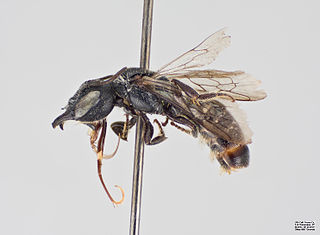Related Research Articles

Melitta is a genus of bees in the family Melittidae. It includes about 40 species restricted to Africa and the northern temperate zone. Most of the species are Palaearctic, though three rare species occur in North America.

The cosmopolitan bee genus Ceratina, often referred to as small carpenter bees, is the sole lineage of the tribe Ceratinini, and is not closely related to the more familiar carpenter bees. The genus presently contains over 300 species in 23 subgenera. They make nests in dead wood, stems, or pith, and while many are solitary, a number are subsocial, with mothers caring for their larvae, and in a few cases where multiple females are found in a single nest, daughters or sisters may form very small, weakly eusocial colonies. One species is unique for having both social and asocial populations, Ceratina australensis, which exhibits all of the pre-adaptations for successful group living. This species is socially polymorphic with both solitary and social nests collected in sympatry. Social colonies in that species consist of two foundresses, one contributing both foraging and reproductive effort and the second which remains at the nest as a passive guard. Cooperative nesting provides no overt reproductive benefits over solitary nesting in this population, although brood survival tends to be greater in social colonies. Maternal longevity, subsociality and bivoltine nesting phenology in this species favour colony formation, while dispersal habits and offspring longevity may inhibit more frequent social nesting in this and other ceratinines.

Epeolus is a genus of cuckoo bees in the family Apidae. They are often known as variegated cuckoo-bees.

Sphecodes is a genus of cuckoo bees from the family Halictidae, the majority of which are black and red in colour and are colloquially known as blood bees. Sphecodes bees are kleptoparasitic on other bees, especially bees in the genera Lasioglossum, Halictus and Andrena. The adults consume nectar, but because they use other bees' provisions to feed their offspring they do not collect pollen.

Chelostoma is a genus of bees in the Osmiini tribe of the family Megachilidae. The genus is divided into 5 subgenera with at least 60 described species.

Trachusa is a genus of leafcutter, mason, and resin bees in the family Megachilidae. There are at least 50 described species in Trachusa.

Panurginus is a genus of bees in the family Andrenidae. There are more than 50 described species in Panurginus.

Protosmia is a genus of subgenus Chelostomopsis in the family Megachilidae. There are more than 30 described species in Protosmia.

Pseudoanthidium is a genus of bees belonging to the family Megachilidae. The species of this genus are found in Eurasia, Africa and Australia.
References
- ↑ "Osmia Genus Information". BugGuide.net. Retrieved 2018-02-27.
- ↑ "Osmia Report". Integrated Taxonomic Information System. Retrieved 2018-02-27.
- ↑ "Osmia Overview". Encyclopedia of Life. Retrieved 2018-02-27.
- ↑ "Browse Osmia". Catalogue of Life. Retrieved 2018-02-27.